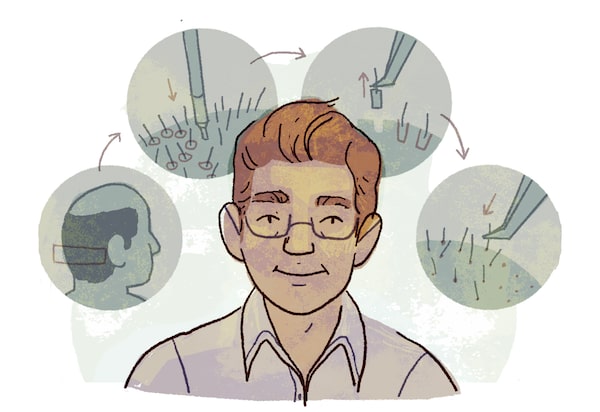First Person is a daily personal piece submitted by readers. Have a story to tell? See our guidelines at tgam.ca/essayguide.

Illustration by Marley Allen-Ash
“You’re going bald,” my friend announced. He said it with no small measure of disgust – as if it was some moral failing.
That was the start.
At first, I blamed the balding on a bad haircut. The barber should never have used the shears on top. He cut too close to the scalp, which took a long time to grow back. Just shave it off, someone else said, but I’d seen a few pictures of myself from behind; large craniums don’t do well with shaving. In my case, bald is not beautiful.
But all was not lost: I still had “the flop.”
Hair doesn’t stand straight up. It grows and flops. So, the hair from one good area can cover for its less productive neighbour, like at a government job. But if the slackers outnumber the workers, it will eventually show. So, it was with my hair. The functioning follicles couldn’t cover the slackers forever.
At times of mental strength, I think, “It’s just hair, don’t be so shallow.” That usually lasts until I pass the first mirror.
Going bald has made me view the world differently. I resented all those men, 25 years older than I, who didn’t have to make 25 square centimetres of hair do the work of 50. They didn’t need to self-consciously pat down the flop so the hairs didn’t expose the steady progression of baldness. They didn’t walk through WalMart exits, looking up at the exit camera and shuddering at the massive white puddle on their crown.
Eventually, dignity was abandoned, and I used brown keratin powder and hair spray to cover the bald patch. The powder looked like crumbled flakes of brown Parmesan cheese. When I woke up, my pillows would have stains, and beads of brown sweat ran down my forehead when I worked out.
Then I heard about discount hair transplants in Turkey. The treatment sounded medieval: Pull good hairs from the back of your head, cut channels in the balding area, graft them in and hope they take root. The actual surgery seemed less technical than the web description but the reviews were good enough, so I booked my ticket.
In Istanbul, I was met by a driver from the clinic. They put me up at a hotel; the following day I went to the transplant office in the hotel basement at 9 a.m.
Bilah, the clinic director, met me. He was clean-shaven with thick black hair and he smiled as he leaned back behind his desk. He wore a crisp white collared shirt and an expensive-looking gold chain around his neck.
He methodically ran me through my day: the surgery would happen on the third floor, I’d be taken back to my hotel, and then to the airport to fly home the following day. It was high-tech; they had done thousands of them. Did I bring cash? US$2,000, please.
In the operating room, I lay on my chest, my face pushed into a rubber circle to hold it still. The first order of business was to rip the follicles out of the back of my head and put them in a petri dish. The least painful part of the nine-hour surgery was the channel cutting. It was just like my Uncle Dave had taught me all those years ago on the farm when he showed me how to graft trees.
By early afternoon, the extractor was tired. A new technician, the tweezer man, spent five hours putting those follicle plugs into those tree-like scalp channels. Each follicle insertion made me wince. Ouch. Wince. Ouch.
I spent that day staring at a white and brown speckled tile floor, listening to my technician flirt in Turkish with the pretty nurse. Stab, stab, stab, stab. Painkiller, please. Don’t be a baby. Stab. Stab. Stab.
The result was like tiny brown pins had been inserted in my head.
A lady came in with a bucket to clean up the blood.
Once I got back to Canada, the idea of nobody noticing was a foolish dream; it took a week for the dried blood to fall off. My university students looked horrified when I came to teach my class the following week. I wasn’t allowed to wear a baseball cap, as it was too tight for the delicate new shoots of hair, a bandana would have been a bit too pirate-like for me, and the special “protect your head” hat given to me by the grafting technician was beyond the grasp of my fading self-esteem.
“I had a hair transplant,” I said as I stood at the podium. “It will take a year to fill in. Get used to it.”
And it did fill in: I used special shampoos, stayed out of direct sunlight, took vitamins and slathered on obscure skin creams with Turkish instructions.
Those tiny grafts, like pins, had become stiff bristles of hair, then short hair, and the short hair was now full and thick. I no longer felt pricks of embarrassment looking at my head in random mirrors, and there were compliments from neighbours and friends. Those transplanted grafts had taken root, from the forehead to the crown, they were like new branches indistinguishable from the old.
Paul Finlayson lives in Maple, Ont.